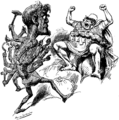Hekatonkheires facts for kids
The Hekatonkheires (pronounced Heck-ah-ton-KEER-ees) were amazing creatures from ancient Greek myths. Their name means "Hundred-handed ones." They were three giant brothers: Kottos, Briareos, and Gyges. These powerful beings were among the first children of Ouranos, the sky god, and Gaia, the Earth goddess.
Contents
Who Were the Hekatonkheires?
The Hekatonkheires were truly unique. Each of them had a hundred strong arms and fifty heads! This is why they were called the "Hundred-handed ones." They were incredibly powerful and strong.
Early Life and Imprisonment
Sadly, their father, Ouranos, did not like his Hekatonkheires children. He was afraid of their great power. Because of this fear, he threw them into a dark, deep prison called Tartarus. This was the lowest part of the Greek underworld. Their brothers, the Elder Cyclopes, were also imprisoned there. A scary monster named Kampê guarded them all.
The Great War of the Gods
Many years later, a big war began between the younger gods, led by Zeus, and the powerful Titans. This war was called the Titanomachy. Zeus knew he needed all the help he could get. So, he and his siblings went to Tartarus. They freed the Hekatonkheires and the Elder Cyclopes from their long imprisonment.
The Hekatonkheires were very grateful to Zeus. They joined his side in the war against the Titans. Their incredible strength was a huge advantage. During the battles, they threw massive rocks at Mount Othrys. This mountain was the Titans' main base. They threw so many rocks that the mountain was cut in half!
Guardians of Tartarus
After a long and fierce war, Zeus and his allies won. The Titans were defeated. As punishment, Zeus cast the Titans into Tartarus, the same prison where the Hekatonkheires had been held. Zeus then gave the Hekatonkheires a very important job. He made them the permanent jailers of the Titans. They stood guard, making sure the powerful Titans could never escape their prison.
Images for kids
-
The Hundred-Hander Briareus used as an allegory of the multiple threat of labour unrest to Capital in a political cartoon, 1890
See also
 In Spanish: Hecatónquiros para niños
In Spanish: Hecatónquiros para niños




